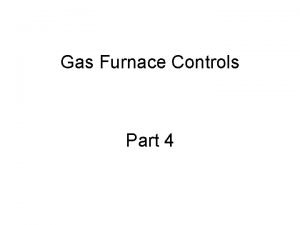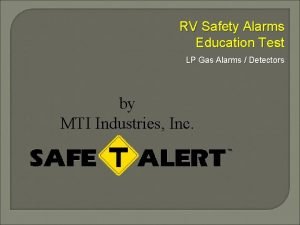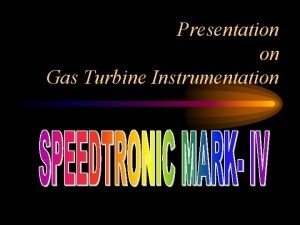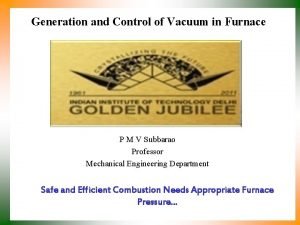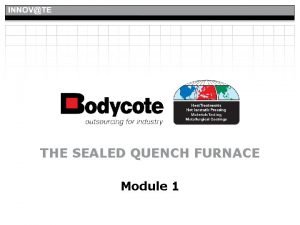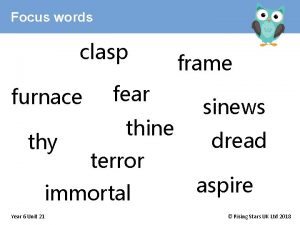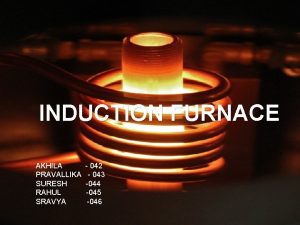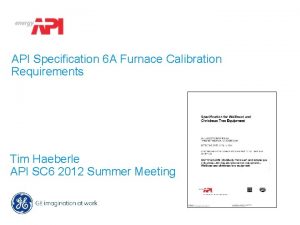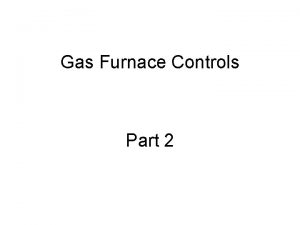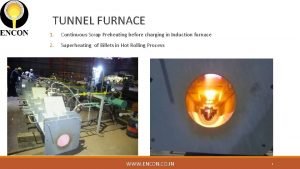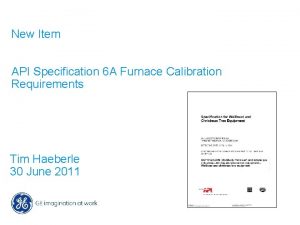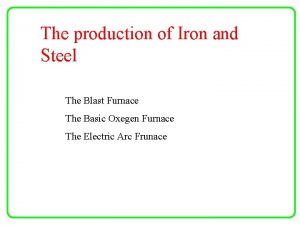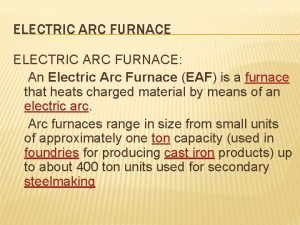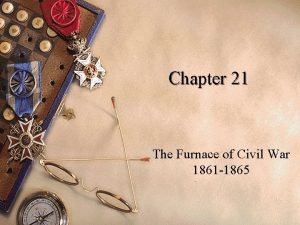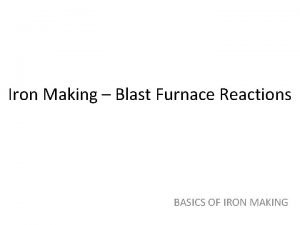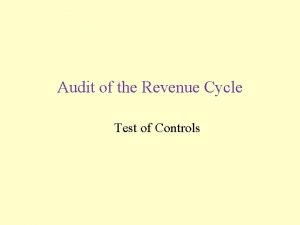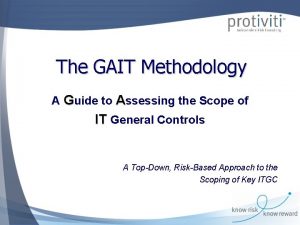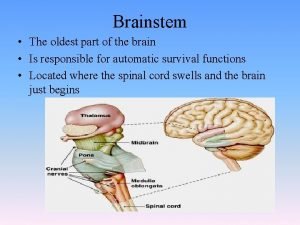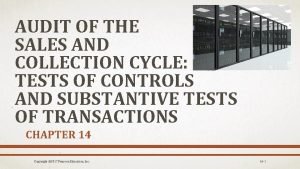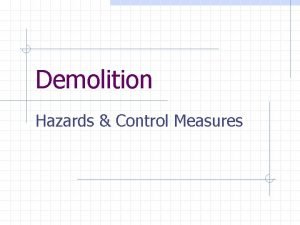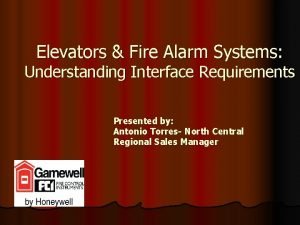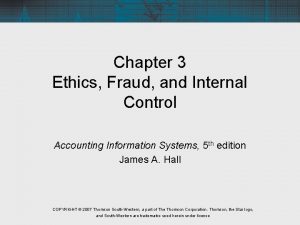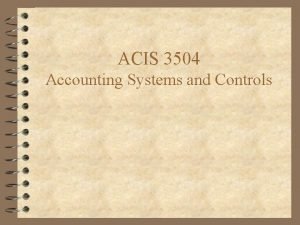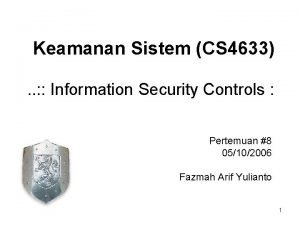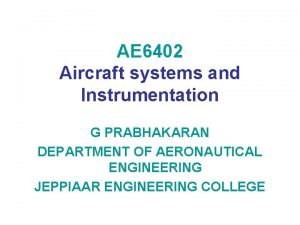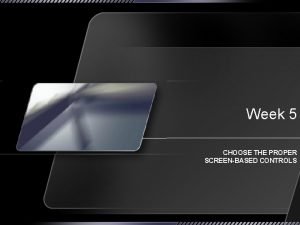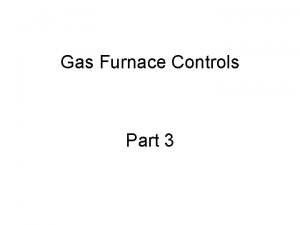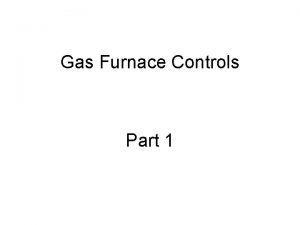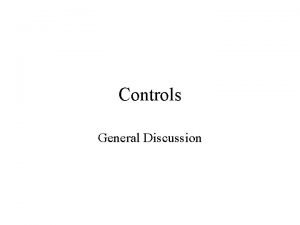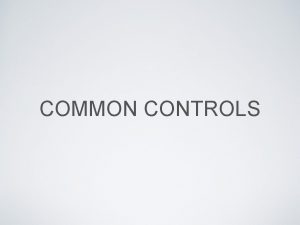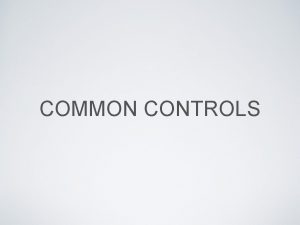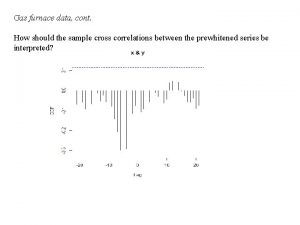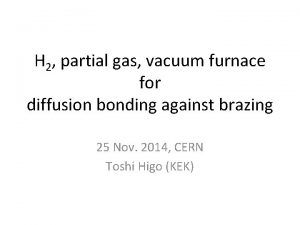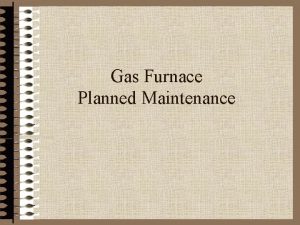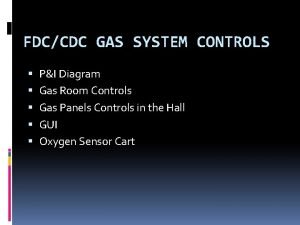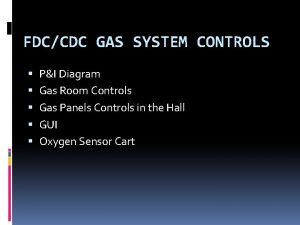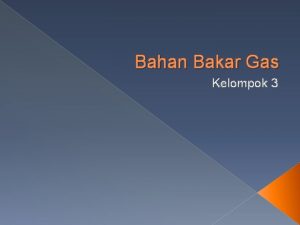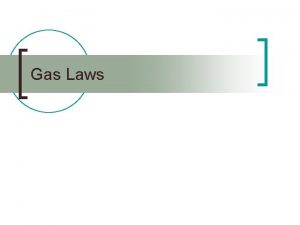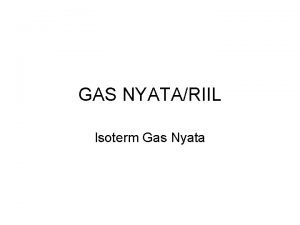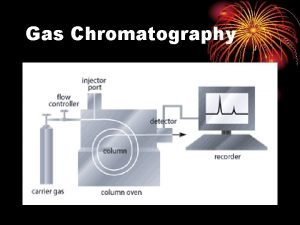Gas Furnace Controls Part 4 Gas furnace controls






































































- Slides: 70

Gas Furnace Controls Part 4

Gas furnace controls – part 4 will review Group IV of the four groups of controls systems. The next slide will show all four groups as a review. Please refer to page A 1 in your Student Handout Packet

The four groups are as follows: I. Manual Ignition with Standing Pilot and Pilot Heat Switch II. Manual Ignition with Standing Pilot and Thermocouple III. Automatic Ignition with Standing Pilot IV. Pilotless Ignition Systems

We will now look at the details of Group IV. Pilotless Ignition Systems

Pilotless Ignition Systems basically means that there is NO standing pilot.

Pilotless Ignition Systems The sequence of operation of pilotless ignition systems will either: 1. light a pilot, prove the pilot is lit, open the main gas valve to the main burners and the pilot will light the gas and keep operating, or 2. light the main burners, prove they are lit and keep operating.

Pilotless Ignition Systems There are two systems this presentation will review. They are: 1. Hot Surface Ignition (HSI) 2. Direct Spark Ignition (DSI) power point

Pilotless Ignition Systems The two systems are represented in your Student Handout Packet. These two systems are found in the A 9 section and the A 10 section.

Before we take a look at these two pilotless ignition systems, we need to review two flame characteristics. 1. Flame conductivity 2. Flame rectification

Flame Conductivity A physical property of a flame is that it will pass current through it. amount of current. It will be a VERY SMALL

Flame Conductivity The way it works is that the control module sends out an AC voltage. The flame conducts current both ways with the same size flame sensors, so the control module will ‘see’ an AC input in response to the AC signal it sent out.

Flame Conductivity Flame Sensors Control Module

Flame Conductivity Gas from either the pilot burner or the main burners make contact with both flame probes. Control Module

Flame Conductivity In this situation, the flame will ‘conduct’ the AC from and back to the control module. Control Module

Flame Conductivity Flame conductivity had some issues with false sensing and that is not good with gas equipment. So ‘flame conductivity’ is no longer used.

Flame Rectification Flame rectification has replaced flame conductivity and is a better flame sensing system.

Flame Rectification Notice that there are still two sensors, but one is very large compared to the other one. The larger one is usually the metal housing of the furnace, so it is large compared to a pencil lead sized probe. Flame Sensors Control Module

Flame Rectification Gas from either the pilot burner or the main burners makes contact with one probe. The other probe is the furnace housing, which is connected to the control module. Furnace housing Control Module

Flame Rectification In this situation, the flame will ‘conduct’ AC from the control module, but due to the size difference of the probes, only a ‘rectified’ AC wave will return. So the rectified current will actually appear to be DC and the control module is designed to only sense this DC. So if it senses AC, it knows something is wrong and will shut down the furnace. Control Module

Flame Rectification This is what the sine wave looks like in the rectification circuit. A lot of flow in one direction, but very little flow in the opposite direction. Control Module

Now onto Hot Surface Ignition (HSI)

Hot Surface Ignition (HSI) A representation of this system is found in your Student Handout Packet, section A 9.

Turn to page A 9 c to review the schematic, which is shown below.

A review of the following components found on this HSI system. 1. Main valve/Redundant valve 2. Flame Sensor Probe 3. Control Module 4. Hot Surface Ignitor

Main valve/Redundant valve The main valve and redundant valve are actually 2 valves in one housing that are piped in series. They both must be open for gas to flow to the burners, but if either one does NOT open or closes during operation, no more gas flows to the main burners.

Main valve/Redundant valve One valve would do the job, but because there are two, it is considered ‘redundant. ’ This feature is for safety considerations.

Main valve/Redundant valve Look at the schematic and notice how the two valves are electrically connected. They are wired in parallel. This means that both valves will get voltage at the same time and they will open together.

Main valve/Redundant valve To review, the main valve and redundant valves are PIPED in series, but WIRED in parallel.

Flame Sensor Probe The ‘flame sensor probe’ may also be known as the ‘flame probe’ or ‘flame rod. ’ It is a piece of stainless steel that one end is inserted into the gas flame, and the other end is connected to the control module.

Flame Sensor Probe

Flame Sensor Probe The ‘flame sensor probe’ function is to sense the flame. More on how it does this later.

Control Module The ‘Control Module’ is the brains behind the operation. It starts the sequence of operation and will provide safety shutdown if it detects anything is wrong either during start-up or during the running time of the equipment. We will go over its sequence of operation later.

Hot Surface Ignitor The hot surface ignitor can be either silicone carbide or silicone nitride. When either device receives the voltage that it is rated at, it will get very hot and glow. This then becomes the high tech version of the older ‘glow coil’ presentation. described in a previous

Several Hot Surface Ignitor Configurations Silicone Nitride Silicone Carbide

Several Hot Surface Ignitor Configurations Silicone Carbide with a shield for protection

Now that we have gone through each of the components of an HSI system, we will go through the sequence of operation. This sequence is also available on page A 9 c of your Student Handout Packet.

HSI Sequence of Operation

Power is supplied to the furnace

Thermostat calls for heat, control module is energized

Control module starts the ignition sequence, silicone carbide ignitor is energized and gets ‘hot. ’

After approximately 17 or 45 seconds, control module energizes terminals MV and MV, both gas valves are energized and gas flows to the burners.

Flame sensor senses flame and ‘rectifies’ the current. Proof of ignition has occurred. Flame conducts current from sensor to ground of furnace housing.

After proof of ignition has occurred, control module will de-energize HSI.

This completes the sequence of operation.

Look at the control module and the terminal identification for the valves. You see MV and MV.

MV and MV is abbreviated for Main Valve. What you don’t see is a PV for PILOT VALVE. This means that this control system does NOT have a separate pilot. The main burner gas is ignited and serves in place of the pilot gas. The control system proves ignition for the main burners.

Checking the flame circuits microamps (µa).

1. Remove the flame sensor wire from the control module. Wire removed here

2. Insert your microamp meter, set for DC current, and read the µa. Check with manufacturer for µa value. a µa meter inserted here µa

Now onto Direct Spark Ignition (DSI)

Direct Spark Ignition (DSI) A representation of this system is found in your Student Handout Packet, section A 10.

Turn to page A 10 e to review the schematic, which is shown below.

You should observe the following about this circuit.

1. There is NO flame sensor identified. The ‘flame sensing loop’ is the ground (GND) wire plus the high voltage wire used for the spark.

2. When you want to check the flame rectification circuit, you would break the GND wire. µa µa meter inserted here

3. Notice there is a ‘pilot burner. ’ This means there is a pilot that is lit before the main burners.

4. Notice there are three terminals marked: MV, MV/PV, PV. This ignition system uses two valves in the same housing: pilot valve and main valve.

5. The MV/PV terminal would be ‘common’ to both valves as shown below. MV PV

Direct Spark Ignition (DSI) Sequence of operation The sequence of operation and troubleshooting this circuit may be found in the Student Handout Packet A 10 section. A brief version is found on the next several slides.

Direct Spark Ignition (DSI) Sequence of operation 1. Thermostat calls for heat. 2. The control module energizes the ignition transformer so that a high intensity spark is created at the pilot burner. The control module, at the same time, will energize terminals MV/PV to open the pilot valve.

Direct Spark Ignition (DSI) Sequence of operation 3. Pilot gas flows to the pilot assembly and is lit by the spark. 4. The pilot flame will then allow current to flow across the spark gap from the high tension cable through the GND wire.

Direct Spark Ignition (DSI) Sequence of operation 5. The control module will sense ‘proof’ of pilot flame and will then energize terminals MV/PV to MV and allow the main valve to open to the main burners.

In conclusion, you can determine the sequence of operation of these two systems by looking at the schematic. If the schematic shows the control module with MV, MV/PV and PV, then there will be a pilot valve and a main valve. If the control module only has MV and MV, then there is no pilot valve.

The sequence of operation would be either: 1. light pilot, prove pilot flame, then open main valve or 2. light main burners, prove main burner flame. In either sequence, there is NO standing pilot. Therefore it is a pilotless ignition system.

This concludes the information relating to ‘Group IV. ’ Refer to your textbook for additional information.

Miscellaneous Information (for tests)

When troubleshooting, what are three circuits a technician might have to troubleshoot? 1. Power 2. Control 3. Safety

What are the first three things you do when you arrive on the job? 1. ASK the customer what they observed. 2. Check that the system switch on thermostat is properly set. 3. Set thermostat to call for MAXIMUM heat.

Continue onto the next power point presentation in this series. Look for the title: Fan and Limit

The End
 Atmosphere furnace controls
Atmosphere furnace controls Gas furnace sequence of operation flow chart
Gas furnace sequence of operation flow chart General controls vs application controls
General controls vs application controls He who controls the past controls the future
He who controls the past controls the future What does the shaded organ refer to in the diagram below
What does the shaded organ refer to in the diagram below Cci controls lp gas detector
Cci controls lp gas detector Gas turbine instrumentation
Gas turbine instrumentation Fortis commissioning sheet
Fortis commissioning sheet Furnace
Furnace Exothermic atmosphere furnace
Exothermic atmosphere furnace Sealed quench
Sealed quench Fearthine
Fearthine Disadvantages of induction furnace
Disadvantages of induction furnace Medaccred oven
Medaccred oven Rotary hearth furnace
Rotary hearth furnace Daniel's friends in the fiery furnace
Daniel's friends in the fiery furnace Sae ams2750
Sae ams2750 Furnace solenoid
Furnace solenoid How is comparative analysis used in engineering economy?
How is comparative analysis used in engineering economy? The furnace of civil war
The furnace of civil war Continuous induction furnace
Continuous induction furnace Asme 2750 furnaces
Asme 2750 furnaces Blast furnace charge
Blast furnace charge How is steel made
How is steel made Electric arc furnace temperature
Electric arc furnace temperature The furnace of civil war
The furnace of civil war Daniel's friends in the fiery furnace
Daniel's friends in the fiery furnace Naumann reversion reaction
Naumann reversion reaction Minitab adalah
Minitab adalah Part whole model subtraction
Part whole model subtraction What is a technical description?
What is a technical description? Part to part ratio definition
Part to part ratio definition Footed ware glass types
Footed ware glass types The phase of the moon you see depends on ______.
The phase of the moon you see depends on ______. Part part whole
Part part whole Volume molare
Volume molare Sutherland's law
Sutherland's law Flue gas desulfurisation gas filter
Flue gas desulfurisation gas filter Hukum laju terintegrasi
Hukum laju terintegrasi Pseudo reduced specific volume
Pseudo reduced specific volume Gas leaked in bhopal gas tragedy
Gas leaked in bhopal gas tragedy Poisonous gas leaked in bhopal gas tragedy
Poisonous gas leaked in bhopal gas tragedy Gas exchange key events in gas exchange
Gas exchange key events in gas exchange An ideal gas is an imaginary gas
An ideal gas is an imaginary gas Gas leaked in bhopal gas tragedy
Gas leaked in bhopal gas tragedy Difference between ideal gas and real gas
Difference between ideal gas and real gas Differences between ideal gas and real gas
Differences between ideal gas and real gas Iso 27001 controls
Iso 27001 controls Test of controls for revenue
Test of controls for revenue Itgc audit methodology
Itgc audit methodology Corrective controls examples
Corrective controls examples What is the oldest part of the brain
What is the oldest part of the brain Custom controls in asp.net
Custom controls in asp.net Internal controls for sales and collection cycle
Internal controls for sales and collection cycle Demolition hazards and control measures
Demolition hazards and control measures Elevator shunt trip requirements
Elevator shunt trip requirements Infectious disease quality controls
Infectious disease quality controls Internal controls case study examples
Internal controls case study examples Negative vs positive control
Negative vs positive control Chapter 3 ethics fraud and internal control
Chapter 3 ethics fraud and internal control Sw suwitupc
Sw suwitupc Acis 2116
Acis 2116 Physical technical and administrative controls
Physical technical and administrative controls Processing integrity controls
Processing integrity controls Eservice.insw.go.id tracking
Eservice.insw.go.id tracking Inner and outer controls work against deviance
Inner and outer controls work against deviance Spiderman 3 ds
Spiderman 3 ds Tango controls
Tango controls Ae6402
Ae6402 Blaise pascal
Blaise pascal Screen based control
Screen based control

